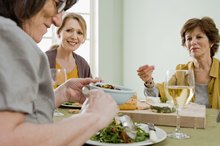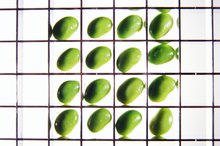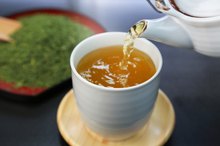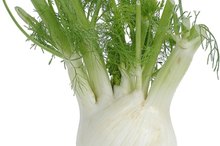Foods that contain phytoestrogens include soy foods such as tofu, soy milk, tempeh and soy protein powder. Other foods have estrogenic effects, meaning that the body can “mistake” them for estrogen: fennel seed and cinnamon are two examples. Women undergoing menopause generally experience declining levels of estrogen, and this can make their menopausal symptoms worsen. Their doctors might advise them to eat foods that have phytoestrogens to help them boost their overall estrogen levels. Overconsumption of isoflavones found in soy foods, however, might increase the risk of cancer in some people. See your doctor first.
Identification of Foods With Phytoestrogens
Other estrogenic foods include:
- alfalfa
- apples
- beets
- carrots
- cherries
- chickpeas
- citrus fruits
- black-eyed peas
- eggs
- cinnamon
- celery
- dairy foods
- eggs
- fennel seed
- flax seeds
- garlic
- potatoes
- wheat
- yams
- pomegranates
- red beans
- sunflower seeds
- tomatoes
- sage
Significance of Foods Comtaining Phytoestrogens
List of Foods That Are Rich in Estrogen
Learn More
While men and children can benefit from eating soy foods for its protein and low fat, foods that contain phytoestrogens are normally emphasized for women experiencing menopause: They need more estrogen. Generally, menopausal women undergo some kind of hormone testing to determine if they need more estrogen--of which there are three types--or another hormone. There is something called estrogen disruptors or xenoestrogens, where different elements in the environment can act like “false estrogens” and be absorbed by the body. The result is a woman who still has a menstrual cycle may be prompted from her exposure to these xenoestrogens to have a second cycle even though she already had one less than four weeks prior. If you are in menopause, ask your doctor if you should include more of the foods listed above to increase your level of estrogen.
- While men and children can benefit from eating soy foods for its protein and low fat, foods that contain phytoestrogens are normally emphasized for women experiencing menopause: They need more estrogen.
Features of Estrogenic Foods
Soy foods were once quite bland and not very palatable: Today, that is not the case. Chocolate soy milk or spicy soy sausage links can be purchased in most health food stores. Women who are on a restricted calorie diet will find that 3 oz. of soy has only 70 calories per ounce and 7 g of protein, similar to an egg and about 23 mg of isoflavones, the dominant type of phytoestrogens. Chinese herbs such as red clover, black cohosh and dong quai may provide isoflavones, and that is why these herbs are featured prominently in PMS and menopausal supplements.
- Soy foods were once quite bland and not very palatable: Today, that is not the case.
- Chinese herbs such as red clover, black cohosh and dong quai may provide isoflavones, and that is why these herbs are featured prominently in PMS and menopausal supplements.
Considerations When Eating Estrogenic Foods
Over-the-Counter Estrogen Substitutions
Learn More
Do not self-diagnose. If you are perimenopausal or in menopause, have your hormone levels tested. Not all women need to add estrogenic foods to their diets: Some women may have too much estrogen and be low in progesterone instead. A saliva home test or an in-office blood test performed by a doctor will provide the information you need to determine if eating phytoestrogenic foods is appropriate for you. Eating certain foods will end up deterring the benefits derived from eating soy foods.
Women with estrogen-fed cancers should consult health care providers and nutritionist in regards to estrogenic foods and other nutritional and diet issues.
- If you are perimenopausal or in menopause, have your hormone levels tested.
- Not all women need to add estrogenic foods to their diets: Some women may have too much estrogen and be low in progesterone instead.
Misconceptions of Estrogenic foods
Soy foods have been consumed by men and women for millennia. Some men may fear that eating soy foods will boost their estrogen levels and “feminize” them. Generally, this is not a genuine risk for men as they produce such large amounts of testosterone. There is a risk for cancer if you overconsume soy foods: One study in 1999 showed that consuming only two servings of a soy-based protein powder providing 45 mg of soy isofavones a day could increase cell growth in women’s breast tissues.
- Soy foods have been consumed by men and women for millennia.
- There is a risk for cancer if you overconsume soy foods: One study in 1999 showed that consuming only two servings of a soy-based protein powder providing 45 mg of soy isofavones a day could increase cell growth in women’s breast tissues.
Related Articles
References
- Cui J, Shen Y, Li R. Estrogen synthesis and signaling pathways during aging: from periphery to brain. Trends Mol Med. 2013;19(3):197-209. doi:10.1016/j.molmed.2012.12.007
- Cui J, Shen Y, Li R. Estrogen synthesis and signaling pathways during aging: from periphery to brain. Trends Mol Med. 2013;19(3):197-209. doi:10.1016/j.molmed.2012.12.007
- Montt-guevara MM, Giretti MS, Russo E, et al. Estetrol Modulates Endothelial Nitric Oxide Synthesis in Human Endothelial Cells. Front Endocrinol (Lausanne). 2015;6:111. doi:10.3389/fendo.2015.00111
- Stages of Menopause. Women’s Health Research Institute Northwestern University.
- Anandhi senthilkumar H, Fata JE, Kennelly EJ. Phytoestrogens: The current state of research emphasizing breast pathophysiology. Phytother Res. 2018;32(9):1707-1719. doi:10.1002/ptr.6115
- How is breast cancer treated?. Centers for Disease Control and Prevention. 2018.
- Hormone Therapy for Breast Cancer. American Cancer Society. 2019.
- Tamoxifen. US National Library of Medicine. 2018.
- Endocrine Therapy for Postmenopausal Women. Johns Hopkins Medicine.
- Diamanti-kandarakis E, Bourguignon JP, Giudice LC, et al. Endocrine-disrupting chemicals: an Endocrine Society scientific statement. Endocr Rev. 2009;30(4):293-342. doi:10.1210/er.2009-0002
- Lecomte S, Habauzit D, Charlier TD, Pakdel F. Emerging Estrogenic Pollutants in the Aquatic Environment and Breast Cancer. Genes (Basel). 2017;8(9). doi:10.3390/genes8090229
- Samavat H, Kurzer MS. Estrogen metabolism and breast cancer. Cancer Lett. 2015;356(2 Pt A):231-43. doi:10.1016/j.canlet.2014.04.018
- Hilakivi-clarke L, De assis S, Warri A. Exposures to synthetic estrogens at different times during the life, and their effect on breast cancer risk. J Mammary Gland Biol Neoplasia. 2013;18(1):25-42. doi:10.1007/s10911-013-9274-8
- Hsieh CJ, Hsu YL, Huang YF, Tsai EM.Molecular Mechanisms of Anticancer Effects of Phytoestrogens in Breast Cancer. Curr Protein Pept Sci. 2018;19(3):323-332. doi: 10.2174/1389203718666170111121255.
- Paterni I, Granchi C, Minutolo F.Risks and benefits related to alimentary exposure to xenoestrogens. Crit Rev Food Sci Nutr. 2017 Nov 2;57(16):3384-3404. doi: 10.1080/10408398.2015.1126547.
Writer Bio
Sava Tang Alcantara has been a writer and editor since 1988, working as a writer and editor for health publications such as "Let's Live Magazine" and "Whole Life Times." Alcantara specializes in health and fitness and is a certified yoga teacher and personal trainer. She does volunteer work regularly and has taught free public yoga classes in Santa Monica, Calif. since 2002.









